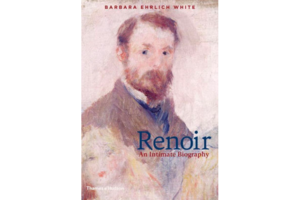'Renoir: An Intimate Biography' shows an artist scarcely hinted at in the sunny swirl of his paintings
Barbara Ehrlich White's new book goes far beyond her earlier work on Renoir.

Renoir
By Barbara Ehrlich White
Thames & Hudson
432 pp.
As Barbara Ehrlich White makes clear in her new book Renoir: An Intimate Biography, the famous Impressionist Auguste Renoir was mind-bogglingly prolific: 4,019 paintings, 148 pastels, 382 drawings, and 105 watercolors over the course of a 60-year career. All of those things sound like the product of a normal industrious artistic career – except the first one: over four thousand paintings. That's a painting every week, with no weeks off, for the whole of his adult life. It speaks of obsessions, compulsions, even demons – odd concepts to connect with someone as genial and self-effacing as Renoir has always been reputed to be, and odd concepts to connect with the paintings themselves, which shimmer with a cheer and strange innocence that still enchant millions of museumgoers all over the world.
White, author of 2010's "Renoir: His Life, Art, and Letters," admits she has an “insatiable fascination” with her subject, and for "Renoir: An Intimate Biography," she has consulted 2,000 more letters than for her previous book – a vast trove of correspondence the painter kept up with his wife, his mistress, his daughter, his sons, his illegitimate daughter Jeanne Tréhot, artist friends like Manet, Matisse, Pissarro, Monet, Cézanne, Degas, and a long parade of patrons.
Renoir was born in Limoges in 1841, and soon after his family moved to Paris in 1844, he was already showing hints of artistic ability. As a teenager, he was employed painting little pictures and designs on the products of a porcelain factory, fairly tedious work Renoir escaped by regularly visiting the nearby Louvre. In 1860, White writes, he was given official permission to make copies in the Louvre, both in the galleries and in the drawing collections; by this point, he'd lost his job when the porcelain factory automated its product decorations, and Renoir was earning money with various makeshift painting jobs when in 1862, he decided to begin studying in Paris with Swiss painter Charles Gleyre.
Through Impressionist exhibitions in the 1870s and steady artistic commissions in Paris, success slowly accumulated. Acclaim among his peers had already preceded it; the greatest painters of his era considered him their luminary. But as White's indefatigable research makes clear, this bright fame had a darker, more complicated side. Renoir the happy family man is clearly visible in the warm, domestic tones of so many of his paintings, and yet White describes in great detail the second life he kept from his wife Aline, the life he led with his mistress Lise and their daughter. The smiling, accommodating Renoir is everywhere in these pages, but so too is the “wheeler-dealer, manipulative and self-serving character” White carefully constructs from letters and accounts of friends. “Renoir was conflict-avoiding, double-talking, secretive, shrewd and even sneaky,” White writes. “To stay in the good graces of those on whom he depended, he ingratiated himself with friends of different opinions whose favour he needed …”
The final decades of Renoir's life, the years of his cresting fame, were increasingly overshadowed by rheumatoid arthritis. Friends and visitors to his home were quietly astonished that the painter kept working despite his increasing debility. In his final years, Renoir could neither walk nor stand nor use his hands with any precision – but he kept painting, grateful, as he put it, to retreat into his art.
Renoir died in December of 1919 at the age of 78, leaving an estate worth millions of francs – an amount that would have been unthinkable to that poor boy wandering the Louvre seven decades earlier. Forty years after his death, his son Jean published his beloved memoir, "Renoir, My Father," a classic of the family-biography genre – with all the blind spots inherent in a son looking back over many years on the nature of his adored father. Barbara Ehrlich White's earlier book was already an invaluable companion and counterweight to the son's memoir; "Renoir: An Intimate Biography" is far beyond that earlier volume, both in the reach of its scholarship and in the insight of its understanding of Renoir's work in all its stages of development. White dismisses the two most dogged slanders to follow the artist around – misogyny and antisemitism – with calm decisiveness, but she's not interested in white-washing genuine shortcomings. The Renoir portrayed here is a generous, cheerful man but also a furtive and sometimes duplicitous one, a painter of genius who often churned out hackwork, a loving husband who constantly worried his wife would find out about the systematic lies he'd been telling her for years. It's a Renoir scarcely hinted at in the sunny swirl of his paintings – and all the more fascinating for that.

